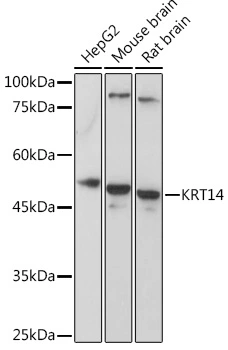![IHC-P analysis of human tonsil tissue using GTX34630 Cytokeratin 14 antibody [KRT14/532]. IHC-P analysis of human tonsil tissue using GTX34630 Cytokeratin 14 antibody [KRT14/532].](https://www.genetex.com/upload/website/prouct_img/normal/GTX34630/GTX34630_20200115_IHC-P_1360_w_23060801_378.webp)
IHC-P analysis of human tonsil tissue using GTX34630 Cytokeratin 14 antibody [KRT14/532].
Cytokeratin 14 antibody [KRT14/532]
GTX34630
ApplicationsFlow Cytometry, ImmunoFluorescence, ImmunoCytoChemistry, ImmunoHistoChemistry, ImmunoHistoChemistry Paraffin
Product group Antibodies
TargetKRT14
Overview
- SupplierGeneTex
- Product NameCytokeratin 14 antibody [KRT14/532]
- Delivery Days Customer9
- Application Supplier NoteICC/IF: 1-2microg/ml. IHC-P: 1-2microg/ml for 30 min at RT. FACS: 0.5-1microg/106 cells in 0.1ml. *Optimal dilutions/concentrations should be determined by the researcher.Not tested in other applications.
- ApplicationsFlow Cytometry, ImmunoFluorescence, ImmunoCytoChemistry, ImmunoHistoChemistry, ImmunoHistoChemistry Paraffin
- CertificationResearch Use Only
- ClonalityMonoclonal
- Clone IDKRT14/532
- Concentration0.2 mg/ml
- ConjugateUnconjugated
- Gene ID3861
- Target nameKRT14
- Target descriptionkeratin 14
- Target synonymsCK14; cytokeratin 14; EBS3; EBS4; K14; keratin 14, type I; keratin, type I cytoskeletal 14; NFJ
- HostMouse
- IsotypeIgG3
- Protein IDP02533
- Protein NameKeratin, type I cytoskeletal 14
- Scientific DescriptionThis gene encodes a member of the keratin family, the most diverse group of intermediate filaments. This gene product, a type I keratin, is usually found as a heterotetramer with two keratin 5 molecules, a type II keratin. Together they form the cytoskeleton of epithelial cells. Mutations in the genes for these keratins are associated with epidermolysis bullosa simplex. At least one pseudogene has been identified at 17p12-p11. [provided by RefSeq, Jul 2008]
- Storage Instruction-20°C or -80°C,2°C to 8°C
- UNSPSC12352203

![IHC-P analysis of human cervix tissue using GTX34630 Cytokeratin 14 antibody [KRT14/532]. IHC-P analysis of human cervix tissue using GTX34630 Cytokeratin 14 antibody [KRT14/532].](https://www.genetex.com/upload/website/prouct_img/normal/GTX34630/GTX34630_20200115_IHC-P_438_w_23060801_896.webp)


![ICC/IF analysis of A549 cells using GTX34629 Cytokeratin 14 antibody [SPM263]. Green : Primary antibody Red : nucleus](https://www.genetex.com/upload/website/prouct_img/normal/GTX34629/GTX34629_20200115_ICC-IF_56_w_23060801_809.webp)
![FACS analysis of trypsinized MeOH-fixed HeLa cells using GTX34631 Cytokeratin 14 antibody [LL002]. Blue : Primary antibody Red : Isotype control](https://www.genetex.com/upload/website/prouct_img/normal/GTX34631/GTX34631_20200115_FACS_1900_w_23060801_995.webp)